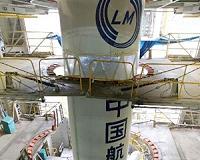 |
Beijing (AFP) Oct 2, 2010 China on Friday celebrated 61 years of communist rule with the launch of its second lunar probe -- the next step in its ambitious programme to become the second country to put a man on the moon. A Long March 3C rocket carrying the Chang'e-2, which is due to go into orbit within 15 kilometres (nine miles) of the moon, blasted off from the launch centre in Xichang in the southwestern province of Sichuan, state media said. China Central Television briefly showed images of the rocket blasting off into the night sky -- a few seconds after lift-off -- before shifting to scenes inside the launch centre and computerised models of the rocket's flight. The unmanned probe will conduct various tests over a six-month period in preparation for the expected launch in 2013 of the Chang'e-3, which China hopes will be its first unmanned landing on the moon. "Chang'e-2 lays a foundation for the soft-landing on the moon and the further exploration of outer space," the official Xinhua news agency quoted the chief designer of China's lunar orbiter project, Wu Weiren, as saying. "It travels faster and closer to the moon, and it will capture clear pictures." The probe successfully entered its trans-lunar orbit, Xinhua said. It will take five days for the Chang'e-2 to arrive at its lunar orbit. It will first circle the moon at a distance of 100 kilometres, before hopefully dropping into orbit 15 kilometres from the moon's surface. The control centre declared the launch a success, Xinhua said, after the solar panels of the probe were unfolded and the satellite began to use solar energy for power supply. The Chang'e programme, named after a mythical Chinese goddess who flew to the moon, is seen as an effort to put China's space exploration programme on a par with those of the United States and Russia. The first lunar probe, launched in October 2007, was in orbit for 16 months. Beijing hopes to bring a moon rock sample back to earth in 2017, with a manned mission pencilled in for around 2020, according to state media. The launch day was symbolic as it is China's National Day, which marks Mao Zedong's proclamation of the founding of the People's Republic in 1949. People arrived early to watch the take-off, an employee at the launch site's tourism department, who refused to be named, told AFP. "A stand has been built for them, and tickets cost 800 yuan (120 dollars)," she said, adding the whole area had been sealed off. China sees its space programme as a symbol of its global stature, growing technical expertise, and the Communist Party's success in turning around the fortunes of the formerly poverty-stricken nation. It became the world's third nation to put a man in space independently -- after the United States and Russia -- when Yang Liwei piloted the one-man Shenzhou-5 space mission in 2003. In September 2008, the Shenzhou-7, piloted by three astronauts, carried out China's first space walk. The Americans have achieved the only manned lunar missions, making six trips from 1969 to 1972. Beijing has other significant Asian competitors to reckon with as it vies to become the second nation to put a man on the moon. India landed a lunar probe in 2008, and a top official said in January it was targeting a manned space mission in 2016. Japan, meanwhile, launched its first lunar satellite in June last year. Earlier this year, China postponed the next step in its space station programme -- the placement of the Tiangong-1 space module in orbit -- until 2011 for technical reasons, state media reported. The Tiangong-1, or "Heavenly Palace," is seen as the building block of China's maiden space station. Weighing about 8.5 tonnes, it would provide a "safe room" for astronauts to live in and conduct research in zero gravity. After being placed in orbit, the Tiangong-1 would dock with the unmanned Shenzhou-8 spacecraft in the country's first space docking -- a feat to be controlled remotely by scientists on the ground. Shenzhou-9 and Shenzhou-10, carrying two to three astronauts, would dock with the orbiting module in successive years, officials have said. The International Space Station began with the launch into orbit of the first station element, a Russian-built module, in 1998. The first full-time crew arrived two years later.
Share This Article With Planet Earth
Related Links The Chinese Space Program - News, Policy and Technology China News from SinoDaily.com
 Rocket Carrying China's Second Lunar Probe Almost Ready For Launch
Rocket Carrying China's Second Lunar Probe Almost Ready For LaunchXichang, China (XNA) Oct 01, 2010 A rocket carrying China's second unmanned lunar probe, Chang'e II, is at its final stage of preparation before launch, the Xichang Satellite Launch Center (XSLC) in southwestern Sichuan Province said Thursday. Fueling of the Long March 3C rocket, the last procedure before its launch, began at 9 a.m. on Sept. 30. Fu Jumei, of the XSLC, said the rocket's first and second stage boosters ... read more |
|
| The content herein, unless otherwise known to be public domain, are Copyright 1995-2010 - SpaceDaily. AFP and UPI Wire Stories are copyright Agence France-Presse and United Press International. ESA Portal Reports are copyright European Space Agency. All NASA sourced material is public domain. Additional copyrights may apply in whole or part to other bona fide parties. Advertising does not imply endorsement,agreement or approval of any opinions, statements or information provided by SpaceDaily on any Web page published or hosted by SpaceDaily. Privacy Statement |